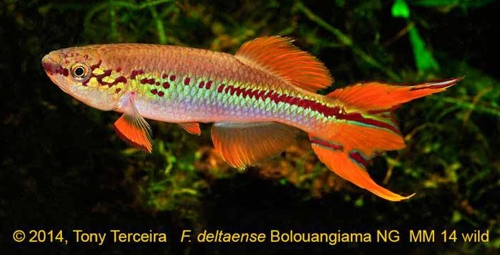

| Meaning of Name |
Referring to the Niger Delta. | ||||||||||||
| First Description |
Radda
A.C. 1976. | ||||||||||||
| Size |
10 cm. | ||||||||||||
| Meristics |
| ||||||||||||
| Karyotype |
| ||||||||||||
| Sub-Genus |
Gularopanchax | ||||||||||||
| Group |
| ||||||||||||
| Synonyms |
| ||||||||||||
|
Populations
|
Bolouangiama NG MM 14
- This was coded NG MM 14 which stands for Nigeria
-Macowiak & Mazzola 2014. From the rich swamp lands of Bolouangiama
Town in present day Bayelsa State, near Port Harcourt City in the
extensive Niger-Delta swamp forests. Collected by Mr. James Ororokuma
& imported into the USA as part of a commercial shipment in 2014.
Koloware CI 05 -
Odieke - Orashi River, southern Nigeria. Collected by Uyi & Otufu in 1991. Rumuokwuta - Near Port Harcourt. Collected by Powell in 1980. Yellow gularis - Described by Arnold in 1934. A broad median line extending into the caudal fin. Irregularly spotted rounded dorsal fin. Anal fin rounded with irregularly spotted with a broad red submargin. Caudal trilobate with bands of contrasting colours. Pectoral fins pointed.
|
||||||||||||
| Type Locality |
Approx. 200 yards south of the Sapele - Benin to Warri road, western Niger Delta. | ||||||||||||
| Distribution |
Restricted to the western Niger Delta area. | ||||||||||||
| Habitat |
Coastal lowlands. They inhabit temporary pools with stagnant water over dark substrate of decaying leaves & bottom mulm. Water depth has been recorded at 30 cm, water temperature 20-30°C. Known to eat ants & other insect sp. | ||||||||||||
| Distinguishing Characteristics |
Only really confused with Fp.gularis.
This sp. has a more randomly spread distribution of red spots on the
sides whereas deltaensis has a more
solid line sometimes shown as a row of red spots. Fp.fallax is another sp. often confused & indeed may be involved with historic descriptions. Easily seperated from fallax - deltaensis is a more chunky looking fish with a more flared caudal fin. Also has a line running horizontally through the body whereas fallax has a series of spots. | ||||||||||||
| Colour/Pattern Variability | Relatively low given the distribution area. | ||||||||||||
| History |
Originally found in a commercial import. They
are regarded to have been collected in the Sapele - Warri area of Nigeria.
| ||||||||||||
| Breeding Notes |
Geoff
Wood gave a breeding report of deltaense in
BKA newsletter No.141, May 1977. He found egg output was quite low when compared
to sjoestedti. Most eggs were laid in large
clumps of peat fibre but occaisionally a few eggs were found in a floating mop.
Collected eggs were stored in damp peat moss for 3 months at about 72°F. First signs of sexing I noticed around 2·5 cm with a dark horizontal line gradually becoming darker. This showed males coming through. At this stage these individuals would become decidedly more aggressive. Jaroslav Kadlec reported that young fry did not like a drop in temperature. Fry would refuse to eat & would be dead within days. He found they did best if raised at 22-23°C for the first 2-3 weeks & then raise the temperature to 24-27°C. BKA Journal 351, December 1994. | ||||||||||||
| Diameter of Egg |
1·6 mm.
| ||||||||||||
| Remarks |
Can be an aggressive sp. & a larger tank
is recommended. |